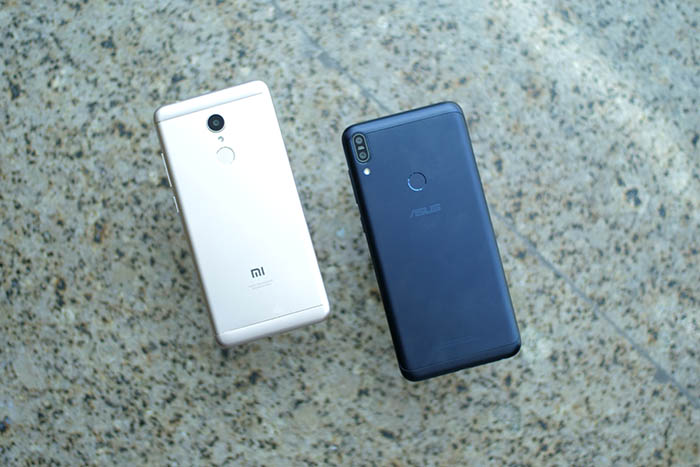Asus’ has just launched the ZenFone Max Pro M1 and it comes with some great specs. Priced starting at ₹10,999 the ZenFone Max Pro M1 is directly in competition with Xiaomi’s budget-offering, the Redmi Note 5. So how does the ZenFone Max Pro M1 compare against Xiaomi’s Redmi Note 5? Well, we did a quick comparison of both the phones to give you an idea of how they stack up:
ZenFone Max Pro M1 vs Redmi Note 5: Specs
| ZenFone Max Pro M1 | Redmi Note 5 | |
|---|---|---|
| Display | 5.99-inches, FullHD+ IPS LCD | 5.99-inches, FullHD+ IPS LCD |
| Processor | Snapdragon 636 | Snapdragon 625 |
| GPU | Adreno 509 | Adreno 506 |
| RAM | Up to 6GB | 3GB/4GB |
| Storage | Up to 64 GB | 32GB/64GB |
| Primary Camera | Dual 13MP f/2.2 + 5MP; 6GB variant comes with 16MP | 12MP f/2.2 |
| Secondary Camera | 8MP f/2.0 | 5MP |
| Battery | 5,000 mAh | 4,000 mAh |
| Operating System | Stock Android 8.1 Oreo | Android 7.1.2 Nougat with MIUI 9 |
| Connectivity | WiFi 802.11 b/g/n, Bluetooth 4.2 | WiFi 802.11 b/g/n, Bluetooth 4.2 |
| Price | Starts at ₹10,999 | Starts at ₹9,999 |
Design and Build Quality
The ZenFone Max Pro M1 is a pretty decent device to look at, and it feels pretty great in the hand. In comparison, the Redmi Note 5 looks a lot like the ZenFone Max Pro M1, including the 18:9 display, the bezel-less curved-corner design, and even the back with the antenna lines running straight through. Both of the phones are pretty well-built and look decent enough.

Both the phones come with a rear-mounted fingerprint scanner, and unfortunately, neither of them has a USB-C port, with both Asus and Xiaomi opting to go for a micro USB port instead for obvious cost-cutting reasons.
Display
Both the ZenFone Max Pro M1 and the Redmi Note 5 come with a 5.99-inch, FullHD+ (1080×2160) IPS LCD display. The displays are comparable to each other in almost every way imaginable, with similar color-reproduction, brightness and visibility in direct sunlight, and sharpness.
Plus, the displays on both the phones have an 18:9 aspect ratio which makes holding the phone a lot easier than it would be with a conventional 16:9 design. Bezels are slimmer on the side, and overall, the displays look quite good.
The ZenFone Max Pro M1 and the Redmi Note 5, both come with great displays for the price, and you can’t go wrong with either one of them.
Cameras
The camera is the first place where there’s really a difference between the ZenFone Max Pro M1 and the Redmi Note 5. While the ZenFone Max Pro M1 comes with a dual rear camera comprising of a 13MP f/2.2 shooter and a secondary 5MP shooter, the Redmi Note 5 only has a single 12MP f/2.2 shooter on the back. So the ZenFone Max Pro M1 has portrait mode while the Redmi Note 5 doesn’t. Photos, in general, come out better from the ZenFone even though it is using the Snapdragon Camera app for some reason. Plus, Asus also announced a 6GB variant of the ZenFone Max Pro M1 which will come with a 16MP camera on the back.
The ZenFone Max Pro M1 also has a portrait mode in the front camera — something the Redmi Note 5 again lacks, and for the most part, the portrait mode works well, but we’ll go in detail in our in-depth review of the phone.
Hardware and Performance
The ZenFone Max Pro M1 comes with a Snapdragon 636 paired with up to 6GB of RAM while the Redmi Note 5 comes packing a Snapdragon 625 with up to 4GB of RAM. Both the phones perform equally well, although the SD636 definitely means the ZenFone Max Pro M1 will perform a tad better at intensive applications such as gaming.
Pair that with the fact that the ZenFone Max Pro M1 is running Stock Android 8.1 Oreo as compared to MIUI 9 on the Redmi Note 5, and I think the ZenFone Max Pro M1 will get a better performance output thanks to the less resource-heavy UI it’s using.
Software
In terms of software, the ZenFone Max Pro M1 is running Stock Android 8.1 Oreo with a couple of third-party apps (including the camera app), and some additional features — a very OxygenOS-like feel to be honest. The Redmi Note 5, on the other hand, comes with the latest MIUI 9 running on top of the aging Android 7.1 Nougat.
With near-stock Android, the ZenFone Max Pro M1 should be able to churn out better performance, but MIUI 9 brings a ton of great features to phones including parallel apps, app-locking, multiple app delete and a lot more. It’s a win-win either way and mostly will end up to personal preference.
Battery
The ZenFone Max Pro M1 comes with a massive 5,000 mAh battery keeping things running, and the Redmi Note 5 comes with a 4,000 mAh battery (which in itself is huge… just not as huge as the ZenFone Max Pro). The batteries on both the phones last quite long, but the ZenFone Max Pro M1 does outlast the Redmi Note 5.
ZenFone Max Pro M1 vs Redmi Note 5: The Best Budget Smartphone?
In conclusion, while the ZenFone Max Pro M1 (starts at ₹10,999) does outdo the Redmi Note 5 when it comes to the processor, and the battery life, both the devices seem pretty evenly matched in real-world usage. Personally, the ZenFone Max Pro M1 is more tempting for me, especially because it comes with near-stock Android, a bigger battery, and dual cameras. That said, we’ll be testing both the phones quite extensively and we’ll give you a final verdict in the full review of the ZenFone Max Pro M1, so keep an eye out for that.